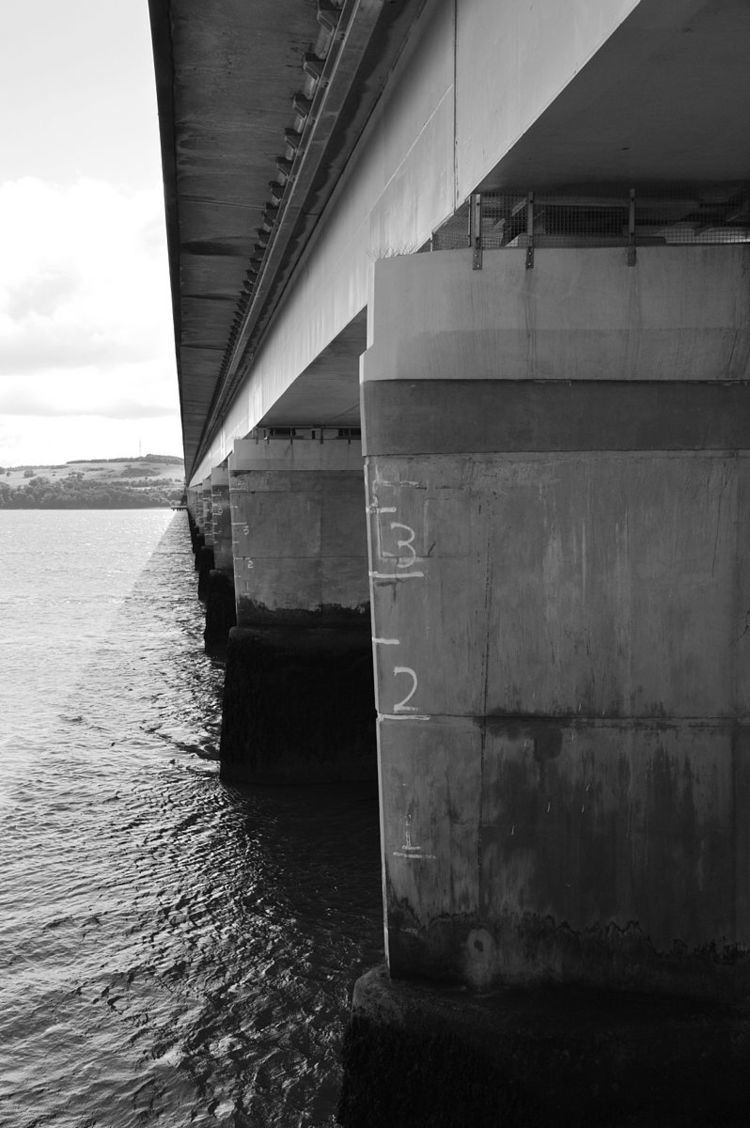Official name Tay Road Bridge Total length 2,250 m | Opened 18 August 1966 Clearance below 38 m Architect William Fairhurst | |
 | ||
Maintained by Tay Road Bridge Joint Board Toll Free since 11 February 2008 Address Tay Road Bridge, Dundee DD1 3JB, UK Similar Tay Rail Bridge, River Tay, Firth of Tay, Friarton Bridge, Dundee railway station Profiles | ||
Tay road bridge
The Tay Road Bridge carries the A92 road across the Firth of Tay from Newport-on-Tay in Fife to Dundee in Scotland, just downstream of the Tay Rail Bridge. At around 2,250 metres (1.4 mi), it is one of the longest road bridges in Europe, and was opened in 1966, replacing the old Tay ferry.
Contents
- Tay road bridge
- Building the tay road bridge
- Construction
- Former Tay ferry service
- Commemorative obelisk
- 50th Anniversary commemoration
- Tolls
- References
Building the tay road bridge
Construction
As part of the modernisation projects of the 1950s, a road bridge across the Tay had been considered for several years. In August 1958 a traffic census and test bores were taken to locate the most suitable crossing for the bridge.
The bridge was designed by William Fairhurst and construction began in March 1963 with the infilling of West Graving Dock, King William Dock and Earl Grey docks in Dundee. The construction was undertaken by Duncan Logan Construction Ltd. Controversially, construction required the demolition of Dundee's Royal Arch where Queen Victoria had entered the city on a royal visit. Rubble from the Victoria arch was used as foundations for the on-ramp.
The bridge consists of 42 spans with a navigation channel located closer to the Fife side. During the construction of the bridge, 140,000 tons of concrete, 4,600 tons of mild steel and 8,150 tons of structural steel was used. The bridge has a gradient of 1:81 running from 9.75 m (32.0 ft) above sea-level in Dundee to 38.1 m (125.0 ft) above sea-level in Fife.
The bridge took 3½ years to build at a cost of approximately £6 million. Following the installation of the final 65 ton girder on 4 July 1966, the completed bridge was officially opened by the Queen Mother on 18 August 1966. A newsreel of this is available in the British Pathe web archive. For four days, many took advantage of the toll-free period to cross the bridge.
Viewing platforms were once a feature of the Bridge, however they were removed in the 1990s.
In 2002, a Tay FM competition to find a slogan for the bridge was abandoned after the slogan with the most votes - “It’s all downhill to Dundee” (reflecting the bridge’s downward angle) was deemed unsuitable.
Former Tay ferry service
The Tay Road Bridge was built to replace the former Tay ferry service, popularly known in Dundee as "the Fifie". A passenger and vehicle ferry service across the River Tay operated from Craigie Pier, Dundee, to Newport-on-Tay. Four vessels formerly operated the service, namely the B. L. Nairn and Sir William High (both Paddle Steamers built in 1929); the Abercraig and the Scotscraig (diesel powered, fitted with Voith Schneider propellors and built in the Caledon Shipyard in Dundee). The final ferry service was made on the day of the opening of the road bridge. The paddle steamers were scrapped while the Scotscraig and Abercraig ended their days in Malta.
The opening of the road bridge on 18 August, 1966, also led to the closure of the railway line from Tayport to Dundee in 1969.
Commemorative obelisk
A 50 ft (15 m) tall obelisk stands at the Newport side, and a smaller one at the Dundee side, to commemorate Willie Logan, managing director of the company that constructed the bridge who was killed in a plane crash near Inverness, and five workers who died during construction. Both of these obelisks are designed as the piers of the bridge, each representing the height of the piers at that end of the bridge.
50th Anniversary commemoration
The bridge was opened formally on 18 August, 1966, by the Queen Mother, and the bridge authorities organised a day of free events on Sunday 21 August 2016 to celebrate the occasion.
Tolls
The bridge was originally a bidirectional toll road with the original 1966 toll for motorcycles, cars and goods vehicles of 1/-, 2/6 and 10/-, respectively. Heavy fines were imposed on drivers who broke down on the bridge if they had run out of petrol. On 1 June 1991, one way tolls were introduced for southbound traffic only.
The legislation enabling the levying of tolls was renewed by Parliament (originally that of the UK but now the responsibility of the Scottish Government) repeatedly, most recently on 1 March 2006, where the toll remained unchanged. Although motorcycles were exempt; the tolls for cars, buses and heavy goods vehicles were 80p, £1.40 and £2.00, respectively. On 31 May 2007, the Scottish Parliament voted to scrap tolls on all bridges in Scotland. This came into effect at midnight on 10 February 2008.
The bridge employs 36 staff comprising the Bridge Manager, 2 administration staff, 15 operational staff, and 18 maintenance staff. These employees are mainly housed in a small administration block to the eastern side of the Dundee end of the bridge.
